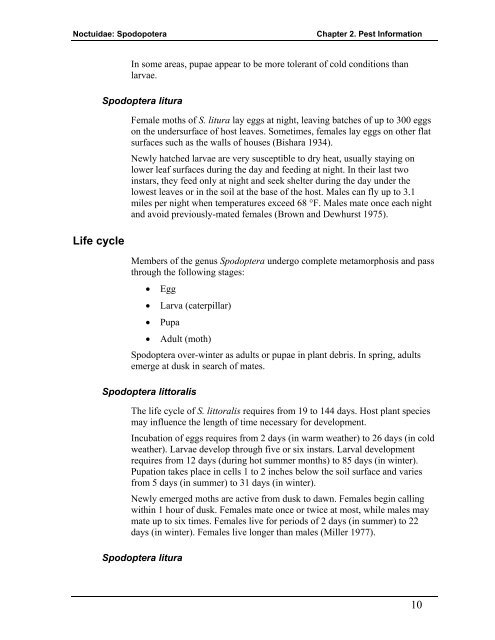New Pest Response Guidelines - Phytosanitary Resources
New Pest Response Guidelines - Phytosanitary Resources
New Pest Response Guidelines - Phytosanitary Resources
Create successful ePaper yourself
Turn your PDF publications into a flip-book with our unique Google optimized e-Paper software.
Noctuidae: Spodopotera<br />
Chapter 2. <strong>Pest</strong> Information<br />
Life cycle<br />
In some areas, pupae appear to be more tolerant of cold conditions than<br />
larvae.<br />
Spodoptera litura<br />
Female moths of S. litura lay eggs at night, leaving batches of up to 300 eggs<br />
on the undersurface of host leaves. Sometimes, females lay eggs on other flat<br />
surfaces such as the walls of houses (Bishara 1934).<br />
<strong>New</strong>ly hatched larvae are very susceptible to dry heat, usually staying on<br />
lower leaf surfaces during the day and feeding at night. In their last two<br />
instars, they feed only at night and seek shelter during the day under the<br />
lowest leaves or in the soil at the base of the host. Males can fly up to 3.1<br />
miles per night when temperatures exceed 68 °F. Males mate once each night<br />
and avoid previously-mated females (Brown and Dewhurst 1975).<br />
Members of the genus Spodoptera undergo complete metamorphosis and pass<br />
through the following stages:<br />
• Egg<br />
• Larva (caterpillar)<br />
• Pupa<br />
• Adult (moth)<br />
Spodoptera over-winter as adults or pupae in plant debris. In spring, adults<br />
emerge at dusk in search of mates.<br />
Spodoptera littoralis<br />
The life cycle of S. littoralis requires from 19 to 144 days. Host plant species<br />
may influence the length of time necessary for development.<br />
Incubation of eggs requires from 2 days (in warm weather) to 26 days (in cold<br />
weather). Larvae develop through five or six instars. Larval development<br />
requires from 12 days (during hot summer months) to 85 days (in winter).<br />
Pupation takes place in cells 1 to 2 inches below the soil surface and varies<br />
from 5 days (in summer) to 31 days (in winter).<br />
<strong>New</strong>ly emerged moths are active from dusk to dawn. Females begin calling<br />
within 1 hour of dusk. Females mate once or twice at most, while males may<br />
mate up to six times. Females live for periods of 2 days (in summer) to 22<br />
days (in winter). Females live longer than males (Miller 1977).<br />
Spodoptera litura<br />
10













